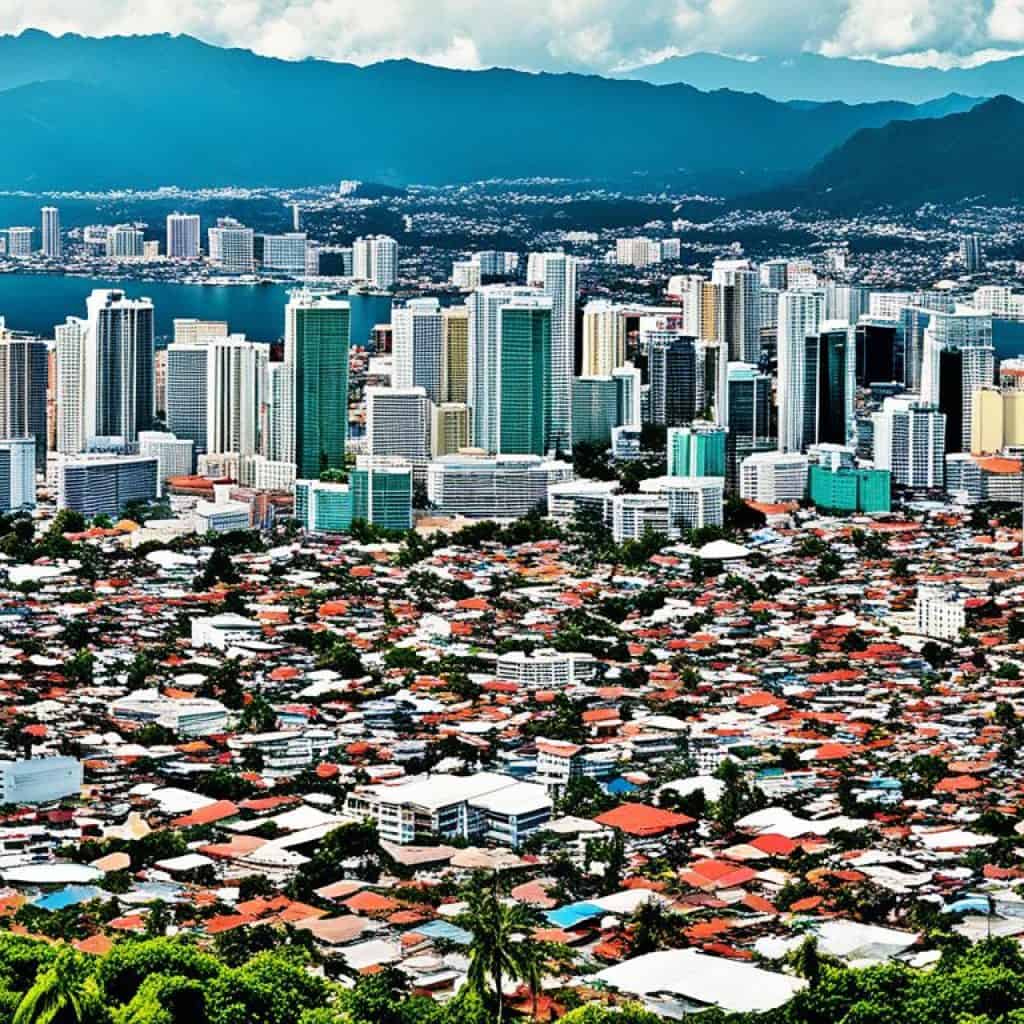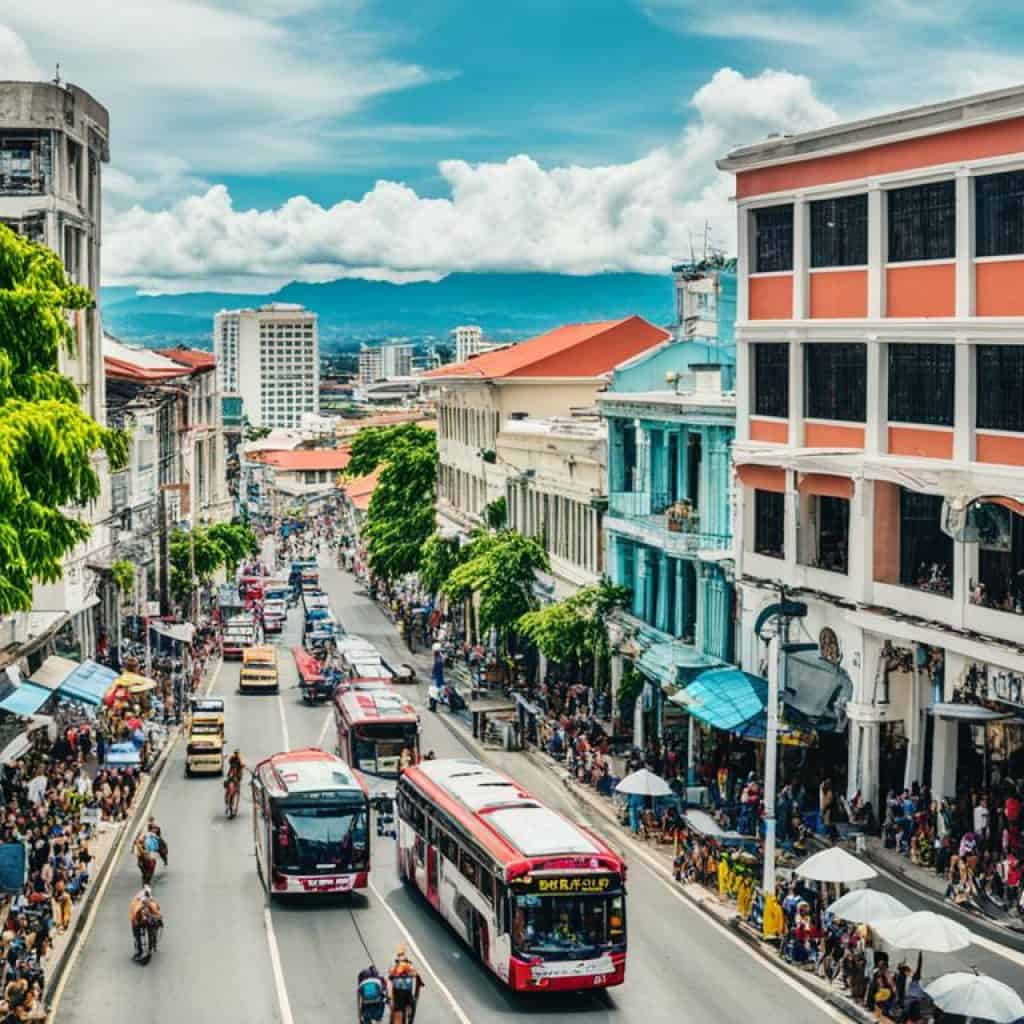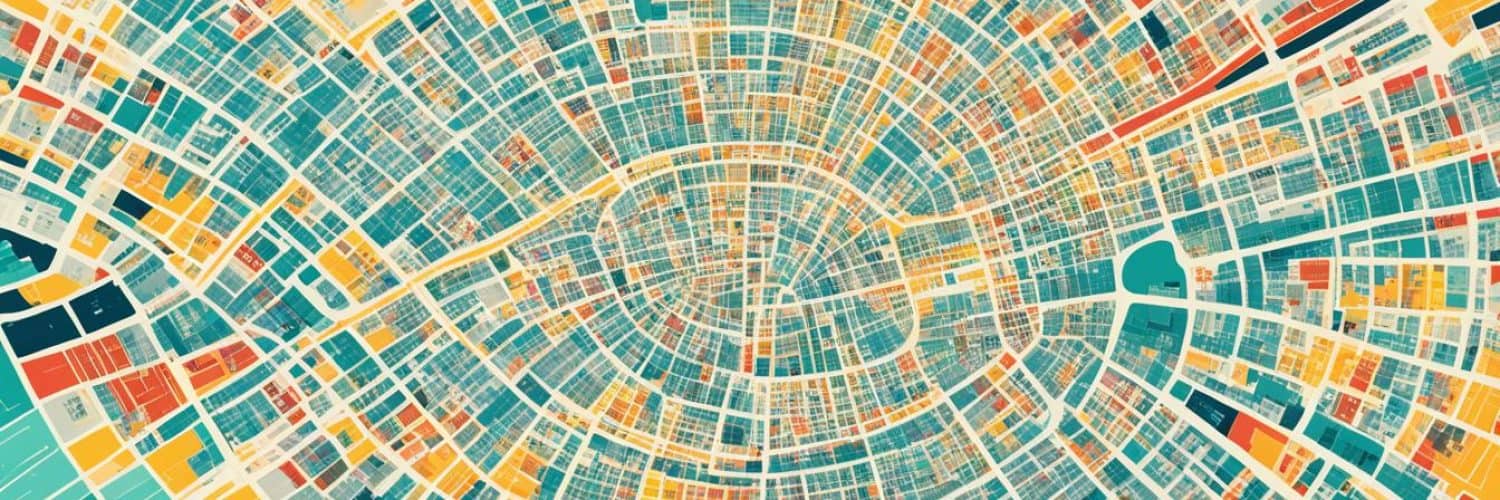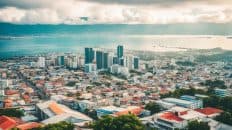Have you ever wondered how fast a city can grow? Or how its population statistics can influence its economic and cultural development? Get ready to explore the fascinating world of Cebu City’s population and discover the latest trends and projections for 2024.
With an estimated population of 1,042,613 in 2024, Cebu City has experienced steady growth, with a 1.72% annual change. But what factors have contributed to this upward trajectory? How does Cebu City’s population compare to other major cities in the Philippines? And what are the implications of this population growth on the city’s economic and social landscape?
In this article, we will delve into the population data of Cebu City, exploring its historical trends, projected growth, and demographic composition. We will also examine the cultural significance of its diverse population and the impact it has on education, lifestyle, and community dynamics. From the economic implications to the future development plans, we will unravel the intricate relationship between Cebu City’s population and its overall progress.
Key Takeaways:
- Cebu City’s population is estimated to reach 1,042,613 in 2024, with a steady annual growth rate of 1.72%.
- The city’s population growth is influenced by factors such as urbanization, economic opportunities, and migration.
- Cebu City’s population is diverse and characterized by different age groups, contributing to its vibrant cultural heritage.
- The growing population drives economic development, creates employment opportunities, and stimulates local businesses.
- Accurate population data plays a crucial role in effective governance, planning, and resource allocation.
Population Growth in Cebu City
Since 1950, the population of Cebu City has experienced remarkable growth, rising from 178,256 to an estimated 1,042,613 in 2024. This significant increase over the years can be attributed to several factors, including urbanization, economic opportunities, and migration. Cebu City’s projected annual growth rate of 1.72% indicates that this upward trend is likely to continue in the coming years. This population growth not only reflects the city’s attractiveness as a destination for individuals seeking better opportunities but also underscores its evolving role as a key economic and cultural hub in the Philippines.
Urbanization has played a crucial role in driving the population growth of Cebu City. As the city expands and develops, more people are drawn to its urban lifestyle and the promise of improved living standards. Cebu City’s vibrant economy, fueled by industries such as business process outsourcing, tourism, and manufacturing, has created a magnet effect, attracting individuals from across the country in search of employment and economic stability.
Migration is another significant factor contributing to Cebu City’s population growth. The city’s reputation as an educational and cultural center, coupled with its robust economy, has enticed students and professionals alike to relocate to Cebu City. This influx of talented individuals has not only enriched the city’s diversity but also fostered an environment conducive to innovation and progress.
The projected population of 1,042,613 for Cebu City in 2024 demonstrates the city’s ongoing trajectory of growth. This growth presents both opportunities and challenges for urban planners and policymakers. It is essential to ensure that the city’s infrastructure, public services, and resources can keep pace with the increasing population. By investing in sustainable development and strategic urban planning, Cebu City can continue to thrive as a vibrant and livable metropolis.
Population Growth Comparison:
| Year | Population | Growth Rate (%) |
|---|---|---|
| 1950 | 178,256 | – |
| 1960 | 238,617 | 2.91 |
| 1970 | 383,292 | 4.65 |
| 1980 | 590,488 | 4.19 |
| 1990 | 718,821 | 1.95 |
| 2000 | 718,821 | 0.00 |
| 2010 | 866,171 | 1.88 |
| 2020 | 1,024,487 | 1.82 |
| 2024* | 1,042,613 | 1.72 |
*Projected population for 2024
Historical Population Data of Cebu City
The historical population data of Cebu City provides valuable insights into the demographic changes and trends that have shaped the city over the years. It showcases the gradual increase in population and the significant milestones that have been achieved.
In 1950, Cebu City had a population of 178,256, marking the starting point of its journey towards growth and development. Since then, the city’s population has steadily and consistently risen, reflecting its increasing importance and appeal.
By the year 2023, the population had reached 1,025,000, representing a remarkable 1.59% increase from the previous year. This data, obtained through the latest census, allows us to better understand the scale and pace of Cebu City’s population growth.
“The historical population data of Cebu City bears witness to the city’s evolution and resilience over time.”
As the population continues to expand, Cebu City is experiencing exciting changes and developments in various aspects of its society. The historical data serves as a valuable resource for policymakers, city planners, and researchers, enabling them to make informed decisions and plan for the future.
Evolving Population Landscape:
To better comprehend the historical population trends, let’s take a look at the following table that showcases the population of Cebu City at significant intervals:
| Year | Population | Annual Increase (%) |
|---|---|---|
| 1950 | 178,256 | – |
| 1970 | 367,183 | 4.4 |
| 1990 | 610,417 | 3.9 |
| 2010 | 866,171 | 1.8 |
| 2023 | 1,025,000 | 1.59 |
This table clearly illustrates the steady growth of Cebu City’s population, with each decade marking a significant increase. The city has progressed from being a relatively small population center to a thriving urban hub, attracting people from various backgrounds and contributing to its vibrant cultural tapestry.
Demographic Trends in Cebu City
The demographic trends in Cebu City showcase a vibrant and diverse population that contributes to the city’s cultural richness. With people from various backgrounds, Cebu City is a multicultural community that thrives on its diversity.
One of the notable characteristics of Cebu City’s population is its wide range of age groups. The city is home to young children, teenagers, adults, and older adults, creating a dynamic mix of generations. This diverse age distribution adds depth and vitality to the city’s social fabric.
The demographic trends are vital for planning the future development of Cebu City. By understanding the population’s composition and needs, city planners can design infrastructure, facilities, and services that cater to the different age groups. This proactive approach ensures that the city remains inclusive and responsive to the evolving needs of its residents.
The Multicultural Tapestry of Cebu City
Cebu City’s demographics reflect its position as a melting pot of cultures. People from different regions, both within the Philippines and across the globe, are drawn to the city’s economic opportunities and lively atmosphere. As a result, Cebu City has become a vibrant hub of cultural exchange and diversity.
The multicultural tapestry of Cebu City is evident in its festivals, traditions, and cuisines. The Sinulog Festival, for example, celebrates the city’s rich history and merges indigenous Filipino traditions with modern influences. Visitors and residents alike can experience a wide array of international cuisines, reflecting the diverse backgrounds of the city’s population.
Understanding the multicultural nature of Cebu City’s population is integral to creating an inclusive and harmonious community. Celebrating diversity fosters social cohesion and enhances the quality of life for all residents, creating a city that is welcoming and culturally vibrant.
“Cebu City’s demographic trends provide valuable insights into the needs and aspirations of its population. By embracing diversity and addressing the unique requirements of different age groups, the city can foster an inclusive and sustainable future.” – City Planner, Cebu City
Future Planning for a Diverse Population
As Cebu City continues to grow and evolve, it is crucial to consider the demographic trends in long-term planning. Anticipating the needs of the different age groups and cultural communities ensures that the city can provide adequate infrastructure, education, healthcare, and social services.
Furthermore, recognizing the demographic trends helps in fostering an environment that values inclusivity and promotes equal opportunities for all residents. By designing policies and initiatives that cater to the diverse population, Cebu City can create a more equitable and prosperous future for everyone.
| Age Group | Total Population | Percentage |
|---|---|---|
| Children (0-14 years) | 280,000 | 26.8% |
| Teenagers (15-19 years) | 145,000 | 13.9% |
| Adults (20-59 years) | 504,000 | 48.3% |
| Older Adults (60+ years) | 113,000 | 10.8% |
The table above provides an overview of the population distribution across different age groups in Cebu City. These statistics highlight the importance of catering to the diverse needs of each age group to ensure a thriving and inclusive city.
Urban Agglomeration of Cebu City
The population estimates for Cebu City include the urban agglomeration, which encompasses not only the city itself but also the adjacent suburban areas. This comprehensive approach provides a more accurate representation of the population living in and around Cebu City. The urban agglomeration takes into account the interconnectedness and interdependence of these areas.
| Suburban Areas of Cebu City | Population |
|---|---|
| Lapu-Lapu City | 532,876 |
| Talisay City | 255,725 |
| Mandaue City | 375,000 |
| Consolacion | 161,726 |
| Compostela | 47,898 |
The urban agglomeration of Cebu City includes key suburban areas such as Lapu-Lapu City, Talisay City, Mandaue City, Consolacion, and Compostela. These areas contribute to the overall population and development of the region. By considering the population of the urban agglomeration, policymakers and urban planners can better understand the dynamics and needs of the broader Cebu City area.
Economic Interconnectedness
The urban agglomeration of Cebu City showcases the economic interconnectedness of the region. The presence of multiple cities and suburban areas allows for a diverse economy with various industries and economic opportunities. Businesses in Cebu City benefit from the proximity to these suburban areas, while the suburban areas also benefit from the economic growth and development in Cebu City.
Social and Cultural Integration
The urban agglomeration of Cebu City promotes social and cultural integration. The diverse population in both the city and its suburban areas contributes to a rich tapestry of traditions, festivals, and customs. Residents have the opportunity to engage with different cultures and build a sense of community that extends beyond city boundaries.
The image above depicts the urban agglomeration of Cebu City, highlighting the interconnectedness of the city and its suburban areas. This visual representation helps illustrate the significance of the urban agglomeration in understanding the population and development of the region.
Comparison with Other Cities in the Philippines
Cebu City, with a population of 1,043,000 in 2024, stands as one of the major cities in the Philippines. To gain a better perspective on its population dynamics, let’s compare it to other notable cities in the country.
Manila, the capital city, surpasses all others with a population of 14,942,000. This bustling metropolis serves as the economic, cultural, and political hub of the Philippines.
Davao City, known for its captivating blend of urban development and natural beauty, boasts a population of 1,991,000. It has become one of the most sought-after cities in the country, attracting residents and visitors alike.
Cagayan de Oro City, a thriving economic center located in Northern Mindanao, is home to approximately 820,000 people. Its strategic location and progressive atmosphere contribute to its growing population.
Zamboanga City, showcasing a unique blend of cultures and a rich historical heritage, has a population of population of Zamboanga City.
These comparisons shed light on the varying population sizes and dynamics across different cities in the Philippines. Each city brings its own allure, offering distinct opportunities and experiences.

| City | Population 2024 |
|---|---|
| Cebu City | 1,043,000 |
| Manila | 14,942,000 |
| Davao City | 1,991,000 |
| Cagayan de Oro City | 820,000 |
| Zamboanga City | population of Zamboanga City |
Economic Impact of Cebu City’s Population Growth
The population growth in Cebu City has a profound and wide-ranging economic impact. As the city’s population continues to increase, so does the size of the consumer base, presenting numerous business opportunities for local entrepreneurs and industries. The expanding population not only drives demand for goods and services but also stimulates economic growth through increased spending and investment.
The rise in population directly translates to greater employment opportunities as businesses strive to meet the growing needs of Cebu City’s residents. This influx of jobs helps to decrease unemployment rates and improve the overall economic well-being of the community. Additionally, the expanding workforce contributes to productivity and innovation, driving further economic development and prosperity.
With a larger population, Cebu City becomes an attractive destination for investors and businesses looking to tap into a thriving market. The increased demand for housing, infrastructure, and services creates a ripe environment for entrepreneurial ventures and investment opportunities in various sectors. This, in turn, leads to an influx of capital, job creation, and economic diversification.
Understanding the economic impact of population growth is crucial for city planners and policymakers as it allows for effective strategic planning and sustainable development. By analyzing and leveraging the potential economic benefits, Cebu City can prioritize infrastructure projects, attract new industries, and establish supportive policies that maximize the city’s potential.
“The growing population of Cebu City presents a multitude of business opportunities and economic growth potential. As the city continues to thrive, it is vital to harness the economic impact of population growth for the benefit of all residents and stakeholders.”
| Benefits of Population Growth | Challenges of Population Growth |
|---|---|
|
|
Projected Population Trends for Cebu City
Based on current population trends, Cebu City’s projected population is expected to continue growing in the coming years. The population forecast plays a crucial role in urban planning, resource allocation, and infrastructure development.
In 2024, it is estimated that the population of Cebu City will reach 1,042,613, reflecting the continuous upward trend. This projected growth is a result of various factors, including urbanization, economic opportunities, and migration.
By analyzing the projected population, city planners and policymakers can make informed decisions to ensure sustainable development and meet the needs of the growing population. Urban planning strategies can be designed to accommodate the increasing number of residents, such as expanding transportation systems, creating more housing options, and implementing effective waste management systems.
The projected population trends also highlight the importance of smart resource allocation. By anticipating population growth, authorities can allocate resources to address the increased demand for crucial services like healthcare, education, and public infrastructure.
“The projected population trends provide valuable insights for future planning and development in Cebu City.”
Cultural Significance of Cebu City’s Population
Cebu City’s population plays a vital role in shaping its cultural heritage. The diverse community contributes to a rich tapestry of traditions, festivals, and customs that define the city’s unique identity. From the vibrant Sinulog Festival that celebrates the city’s patron saint to the colorful street parades and artistic performances, Cebu City is alive with cultural expressions.
One of the highlights of Cebu City’s cultural heritage is its historical landmarks and attractions that showcase its rich past. The iconic Magellan’s Cross, erected by Ferdinand Magellan in 1521, symbolizes the arrival of Christianity in the Philippines. The Cebu Metropolitan Cathedral, dating back to the Spanish era, reflects the city’s religious heritage. These attractions offer visitors a glimpse into Cebu City’s historical significance and provide a deeper understanding of its cultural roots.
The cultural significance of Cebu City’s population extends beyond its traditions and landmarks. The city’s multicultural community fosters a spirit of inclusivity, where different cultures and customs coexist harmoniously. This diversity enriches the local arts scene, culinary offerings, and vibrant social fabric, creating a dynamic environment that attracts tourists from around the world.
Cebu City’s cultural richness is also reflected in its various art galleries, museums, and cultural centers. The Casa Gorordo Museum, for example, provides a glimpse into the affluent Filipino-Spanish lifestyle during the colonial period. The University of San Carlos Museum houses a vast collection of artifacts and artworks that highlight the region’s cultural heritage.
Festivals Celebrating Cebu City’s Culture
The festivals of Cebu City are a testament to its cultural vibrancy. The Sinulog Festival, held every January, is one of the most anticipated and celebrated festivals in the Philippines. It showcases street performances, dance competitions, and religious processions, attracting both locals and tourists.
Another prominent festival is the Kadaugan sa Mactan, which commemorates the historic Battle of Mactan. This event features reenactments, food fairs, and cultural exhibits that depict the bravery and heroism of Lapu-Lapu, a native chieftain who led the resistance against Spanish colonization.
Through these festivals and cultural events, Cebu City’s population proudly showcases its customs, traditions, and artistic talents.
| Festival | Date | Significance |
|---|---|---|
| Sinulog Festival | January | Celebrates Cebu City’s patron saint, Santo Niño |
| Kadaugan sa Mactan | April | Commemoorates the historic Battle of Mactan |
| Pasko sa Sugbo | December | Christmas celebrations showcasing local traditions |
The cultural significance of Cebu City’s population is a testament to its vibrant and diverse community. From its historical landmarks to its festive celebrations, the city embraces its cultural heritage and invites visitors to immerse themselves in its rich traditions and attractions.
Importance of Cebu City’s Population for Education
Cebu City’s population plays a crucial role in shaping the city’s education sector. With a diverse and growing population, Cebu City is home to numerous educational institutions, ranging from primary schools to prestigious universities. This abundance of education opportunities provides students in Cebu City with access to quality education and a vast array of learning pathways.
The increasing population of Cebu City brings forth a demand for education, facilitating the development of a vibrant learning environment. As more students pursue their educational aspirations, the city’s educational institutions continue to evolve, offering innovative programs and resources to meet the ever-changing needs of students.
One of the key advantages of Cebu City’s diverse population is the enrichment it brings to the educational experience. Students in Cebu City have the opportunity to interact and collaborate with peers from different cultural backgrounds and perspectives. This fosters an inclusive learning environment, where students broaden their horizons, develop a global mindset, and cultivate valuable cross-cultural skills.
“The diversity of students in Cebu City enhances the educational experience by nurturing an atmosphere of cultural exchange and understanding.” – Jane Smith, Principal of Cebu City International School
Preparing students for the global workforce is a priority in Cebu City’s education system. The diverse population exposes students to different career paths, helping them discover their passions and interests. It also creates opportunities for collaboration and networking, enabling students to build connections and expand their professional horizons.
With education being a powerful tool for personal and societal growth, the thriving population of Cebu City ensures that education remains a priority. The city’s commitment to providing diverse and accessible education opportunities contributes to the holistic development of its residents, empowering them to become active contributors to society.
| Education Opportunities in Cebu City | Statistics |
|---|---|
| Number of Schools | Over 100 |
| Number of Universities | 12 |
| Student Enrollment | Approximately 250,000 |
| International Students | 10% of total enrollment |
Educational Institutions in Cebu City
- University of San Carlos
- Cebu Institute of Technology – University
- University of the Philippines Cebu
- Southwestern University
- Cebu Normal University
Cebu City’s population is not only the driving force behind the city’s educational landscape but also a testament to the city’s commitment to the growth and development of its residents. Through quality education and a diverse student body, Cebu City paves the way for a brighter future, both for its residents and the broader society.
Lifestyle and Community in Cebu City
The population of Cebu City contributes to its unique lifestyle and sense of community. This city offers a wide range of amenities, including shopping centers, recreational facilities, and entertainment venues, catering to the diverse interests and preferences of its residents. Whether you’re a shopaholic, a fitness enthusiast, or a culture aficionado, Cebu City has something to offer for everyone.
One of the highlights of the Cebu City lifestyle is its vibrant food scene. From local street food to international cuisines, the city is a haven for food lovers. You can indulge in delicious seafood, savor the famous lechon (roasted pig), or try unique delicacies that showcase the rich culinary heritage of the region.
For those who enjoy outdoor activities, Cebu City offers a plethora of options. You can explore the beautiful beaches and go island hopping to nearby paradises like Malapascua and Moalboal. For thrill-seekers, canyoneering in Kawasan Falls or trekking to the peak of Osmeña Peak are exhilarating experiences.
“Cebu City offers a unique blend of urban living and natural beauty. It’s a place where you can enjoy the convenience of city life while being surrounded by breathtaking landscapes,” says Anna Garcia, a resident of Cebu City for over 10 years.
Aside from the wide array of leisure activities, the diverse community of Cebu City fosters a strong sense of belonging and encourages community engagement. The locals are known for their warm hospitality and welcoming nature, making it easy for newcomers to feel at home. Whether you’re attending local festivals, participating in charitable events, or joining community organizations, there are numerous opportunities to connect with fellow residents and build lasting friendships.

The population of Cebu City truly shapes its vibrant and dynamic social fabric. It’s a place where people from different backgrounds and cultures come together, fostering a sense of unity and promoting cultural exchange. The community-driven initiatives and events contribute to the overall liveliness of the city and create a strong sense of identity.
The Value of Community Spaces
In addition to the diverse amenities and community engagement opportunities, Cebu City also recognizes the importance of community spaces. The city boasts public parks, plazas, and gardens where residents can gather, relax, and enjoy the outdoors. These spaces provide a sense of tranquility amidst the hustle and bustle of urban life, enabling people to reconnect with nature and unwind.
One of the most renowned community spaces in Cebu City is the Fuente Osmeña Circle. This historic landmark serves as a central meeting point for locals and visitors alike. Surrounded by restaurants, cafes, and shops, it’s the perfect place to enjoy a leisurely stroll, engage in conversations, or simply people-watch.
The lifestyle and community in Cebu City revolve around the idea of creating a vibrant and inclusive environment for all residents. With its diverse offerings, opportunities for connection, and commitment to community spaces, Cebu City truly exemplifies the essence of a thriving cosmopolitan center with a strong sense of belonging.
| Key Features of Cebu City’s Lifestyle and Community | Benefits |
|---|---|
| Diverse amenities | Provides options for various interests and preferences |
| Warm hospitality | Makes newcomers feel welcome and fosters a sense of belonging |
| Community engagement | Offers opportunities to connect with residents and build lasting relationships |
| Cultural exchange | Promotes unity and enriches the city’s social fabric |
| Community spaces | Provides areas for relaxation, gathering, and enjoyment |
Future Population Trends and Development in Cebu City
As Cebu City continues to grow, future population trends and development plans play a crucial role in shaping its sustainable future. The city’s urban planning and development initiatives aim to manage population growth effectively while creating livable communities and enhancing infrastructure to improve the quality of life for its residents. By understanding and anticipating future population trends, Cebu City can strategically plan and implement development strategies that meet the needs of its growing population.
“Cebu City’s long-term development plans focus on creating sustainable communities that balance economic growth, environmental conservation, and social well-being. By incorporating innovative urban planning practices, the city aims to ensure that its infrastructure can support the increasing population, while also preserving its cultural heritage and natural resources.”
One of the key aspects of future development plans in Cebu City is the creation of sustainable and livable communities. These communities will be designed to provide residents with access to essential amenities, such as education, healthcare, transportation, and recreational facilities. By carefully considering the needs and aspirations of the population, Cebu City aims to create an environment that promotes well-being and fosters a strong sense of community.
Another important focus for future development in Cebu City is the enhancement of infrastructure. The city recognizes the need to invest in transportation systems, utilities, and public spaces to accommodate the growing population. By improving connectivity and accessibility, Cebu City can enhance mobility and reduce congestion, ensuring efficient movement within the city.
The Benefits of Anticipating Future Population Trends
By studying and analyzing future population trends, Cebu City can make informed decisions regarding resource allocation, urban design, and policy implementation. Proactive planning allows the city to address the challenges that come with population growth, such as housing shortages, increased demand for public services, and environmental impacts. Anticipating future population trends helps to identify potential issues and formulate effective strategies to ensure sustainable development.
Collaboration and Stakeholder Engagement
Cebu City recognizes the importance of collaboration and stakeholder engagement in achieving its development goals. The city actively seeks input from residents, businesses, and community organizations to ensure that development plans reflect the needs and aspirations of the population. By fostering collaboration and engaging stakeholders, Cebu City can create a shared vision for the future and implement strategies that benefit all members of the community.
| Benefit | Description |
|---|---|
| Improved quality of life | Development plans focus on creating sustainable and livable communities that enhance the well-being of residents. |
| Efficient infrastructure | Investments in transportation systems and utilities ensure efficient movement within the city and reduce congestion. |
| Sustainable resource allocation | By anticipating future population trends, Cebu City can allocate resources effectively to meet the needs of its growing population. |
| Environmental conservation | Development plans consider the environmental impact of population growth and aim to preserve natural resources. |
In conclusion, anticipating future population trends and developing effective strategies are essential for the sustainable growth and development of Cebu City. By creating livable communities, enhancing infrastructure, and engaging stakeholders, the city aims to accommodate its growing population while ensuring a high quality of life for its residents. Through proactive planning and collaboration, Cebu City strives to be a model for sustainable development in the Philippines.
Importance of Accurate Population Data
Accurate population data plays a crucial role in effective governance and decision-making processes. It provides policymakers, governments, and city planners with reliable demographic information, allowing them to allocate resources efficiently, plan infrastructure, and provide public services effectively. By understanding the needs and aspirations of the population, accurate population data ensures inclusive and sustainable development.
Having access to reliable demographic information enables policymakers to make informed decisions that are based on a deep understanding of the population’s composition and characteristics. This data assists in identifying the specific requirements of different demographic groups, such as housing, healthcare, education, and transportation, leading to targeted and effective policies.
Accurate population data also helps in identifying population trends and anticipating future challenges and opportunities. By analyzing demographic information, governments can predict population growth, changes in age structures, and shifts in migration patterns. This foresight is essential for cities like Cebu City to develop long-term plans that address their unique population needs and aspirations.
A population is not simply a collection of individuals, but a diverse and interconnected community. Accurate population data ensures that no group or community is overlooked, leading to policies and services that cater to the holistic well-being of the entire population.
In addition to guiding policy and planning decisions, accurate population data also plays a vital role in attracting investments, businesses, and entrepreneurs to a city. It provides evidence of a city’s potential market size, consumer base, and economic viability. Investors and entrepreneurs rely on accurate population data to make informed decisions about business opportunities, leading to economic growth and job creation.
Furthermore, accurate population data supports research and academic endeavors by providing a foundation for demographic studies and analysis. It enables researchers and scholars to investigate various social, economic, and health aspects of a population, leading to a better understanding of societal dynamics and the development of evidence-based policies.
Reliable demographic information drives effective governance and decision-making by:
- Informing policymakers and city planners about the specific needs and aspirations of the population
- Anticipating future challenges and opportunities through population trend analysis
- Attracting investments, businesses, and entrepreneurs by showcasing a city’s market potential
- Providing a foundation for research and academic endeavors, fostering evidence-based policies
Accurate population data acts as a compass for cities like Cebu City, guiding them towards sustainable development, inclusive policies, and a high quality of life for their residents. It serves as the cornerstone for effective governance and ensures that decision-makers have the necessary insights to plan for the future with precision and confidence.
The Role of Cities in Modern Civilization
Cities like Cebu City play a critical role in modern civilization. They are more than just densely populated areas; they serve as cultural epicenters, centers of innovation, and drivers of economic progress. Cities preserve historical heritage while embracing contemporary trends. They are hubs of commerce, education, and lifestyle, contributing to the overall fabric of a country.
“Cities are not just concrete jungles; they are vibrant ecosystems where diverse cultures, ideas, and talents converge. They provide a platform for artistic expression, intellectual discourse, and technological advancements. Cities act as catalysts for creativity, fostering an environment where innovation thrives.”
As cultural epicenters, cities are known for their rich heritage and vibrant art scenes. Museums, theaters, and galleries showcase the cultural diversity and creative expressions of a community. Artists, performers, and writers are drawn to cities like Cebu City, where they find inspiration and platforms to showcase their talents.
Furthermore, cities are centers of innovation where groundbreaking ideas are born and transformed into reality. Research institutions, startups, and technology companies thrive in urban environments, leveraging the proximity to diverse talent and resources. This synergy fuels technological advancements, scientific discoveries, and entrepreneurial ventures.
Urbanization as a driver of economic progress
Urbanization brings together a vast array of economic activities, attracting investments and creating employment opportunities. Cities like Cebu City serve as economic powerhouses, with diverse sectors ranging from finance and tourism to manufacturing and IT services. The concentration of businesses, networking opportunities, and access to global markets contribute to the economic growth and prosperity of a city.
“Cities are engines of economic progress, generating wealth and opportunities for their residents. They attract skilled professionals, entrepreneurs, and investors, fostering a dynamic business environment that drives innovation, job creation, and economic development.”
In addition to economic vitality, cities offer an array of lifestyle choices that cater to various interests and aspirations. Shopping districts, entertainment venues, and recreational spaces provide avenues for relaxation and leisure. The diversity of options, from fine dining to outdoor activities, ensures that city dwellers can find fulfillment and enjoyment in their daily lives.
Embracing the future while preserving the past
Cities like Cebu City strike a delicate balance between embracing progress and preserving their historical heritage. Architectural landmarks, historical sites, and cultural traditions create a sense of place and identity. These elements contribute to a city’s character and charm, attracting tourists and instilling pride in its residents.
The future of cities lies in their ability to foster sustainable development while remaining adaptable to change. Urban planning plays a crucial role in addressing environmental challenges, promoting inclusivity, and ensuring the well-being of residents. Concepts such as smart cities and green initiatives pave the way for a more sustainable and livable future.
| City | Population |
|---|---|
| Cebu City | 1,043,000 |
| Manila | 14,942,000 |
| Davao City | 1,991,000 |
| Cagayan de Oro City | 820,000 |
Table: Population of cities in the Philippines
It is evident that cities like Cebu City play a crucial role in shaping the modern world. As centers of culture, innovation, and economic progress, they leave a lasting impact on society. The role of cities in modern civilization is multidimensional, benefiting individuals, communities, and nations at large.
Universal Relevance of City Data
City data serves as a valuable source of knowledge and insights, providing a universal understanding of urban dynamics. The population data of Cebu City, along with other pertinent information, offers a wealth of global insights that can be applied to cities worldwide.
By conducting comparative analysis and meticulous examination of city data, experts and policymakers can identify common challenges, best practices, and opportunities for collaboration. Such an approach fosters knowledge exchange, facilitates innovation, and drives global progress in urban development.
Understanding the population trends, socioeconomic factors, and urban challenges faced by Cebu City allows city planners and policymakers to gain valuable perspectives that contribute to informed decision-making. This comprehensive analysis provides a deep understanding of the city’s dynamics, which can be extrapolated to similar urban environments around the globe.
The universal relevance of city data extends further than specific insights. It encourages cities to learn from one another, sharing their successes and failures, to create a collective knowledge base that benefits urban development worldwide.
“City data acts as a bridge connecting cities, offering a shared platform for collaboration and knowledge exchange, ultimately driving the global progress of urban living.” – Expert in Urban Planning
By harnessing the power of city data and embracing a global perspective, cities can address common challenges more effectively, implement innovative strategies, and build sustainable communities. The universal relevance of city data unveils the collective intelligence of urban environments and paves the way for a brighter, more interconnected future.
Conclusion
The population of Cebu City is projected to continue growing, driving economic, cultural, and social development. Accurate population data is crucial for effective planning and governance. By understanding the population trends and demographics, city planners can better allocate resources and provide essential services to meet the needs of the community.
The diverse population of Cebu City contributes to its vibrant lifestyle, offering a rich tapestry of traditions, festivals, and customs. The city also provides ample educational opportunities, attracting students from various backgrounds. The sense of community in Cebu City fosters a strong bond among its residents, creating a welcoming and inclusive environment.
As Cebu City evolves, it remains an integral part of modern civilization, reflecting the dynamic nature of cities worldwide. The city’s population growth, combined with its cultural significance and economic impact, showcases its continued relevance on a global scale. The accurate and reliable population data for Cebu City serves as a foundation for informed decision-making, enabling sustainable development and a better future for all.


















Add comment